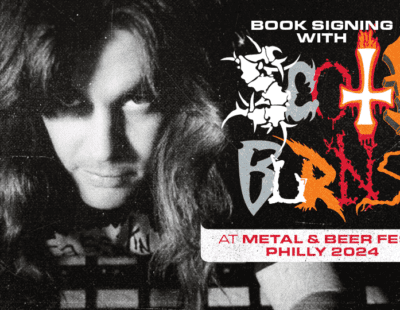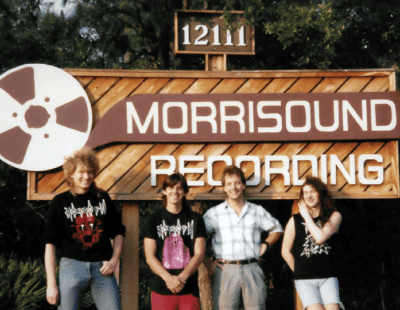
Bazillion Points, the heavy metal publishing house founded by Sound of Beast author Ian Christe, turns 10 this year. To celebrate, Decibel has corralled 10 authors from the BP stable to discuss their own works and what it’s like to part of the world’s heaviest publisher.
Brian Lew, Murder In The Front Row: Shots From The Bay Area Thrash Metal Epicenter
Long before he joined the stable of Bazillion Points authors Brian Lew witnessed the birth of American thrash metal. He knew Metallica when they were a bunch of teenagers working to get better at their instruments, attended historic concerts by almost every future metal juggernaut and edited the zine Whiplash. Murder In The Front Row – which Lew compiled with fellow Bay Area OG Harald Oimoen – has cracked the mainstream much like Metallica did decades ago with a documentary set for future release. Lew – who guided Decibel around Bay Area metal haunts more than five years ago – told us how it happened.
How did you start working with Ian and Bazillion Points?
At the time I wasn’t really in touch with my old buddy and co-author Harald Oimoen. Monte Connor of Nuclear Blast introduced Harald to Ian Christe with the idea of a book based on his old photos. At the same time, unknown to me, Ian had been reading my old blog where I posted a lot of old metal war stories. Ian suggested creating a book with both Harald and myself and the rest is history. The metal gods work in mysterious ways.
Did you have any other offers on the table?
No, because the idea of Murder In The Front Row was Ian’s. To be completely honest, I would not have done a book with anyone else. Bazillion is more of an archivist of music history rather than a publisher. Rock photo books are a dime a dozen, and most of them are merely photos slapped on pages. What I love about Bazillion is that they always create a narrative, so it reads like a documentary film. Here is another reason why Bazillion was the only home for Murder: All of the fonts used in the book (the cover, the text, the photo captions) are the same fonts used on the album covers and liner notes of Kill ‘Em All, Bonded By Blood, and Reign In Blood! That was Ian’s Easter Egg idea! Brilliant.
How has publishing the book changed your life and Harald’s?
I can only speak for myself, but for years I was detached from the original Bay Area metal days because I had moved on to other music and interests. My old negatives followed me around over the years in a shoebox. When the book came out, it was profound to learn how much those old days had meant to others. They were sacred times. It’s also a little weird to be recognized in random places by people who have a copy. This week I’ve been in New York City for work, and a Murder reader came up to me at a work event to tell me how much he loves the book. Amazing.
Do you have a favorite image in the book?
My favorite Murder image is the one by Harald of Hetfield with Clive the Dog. Clive lived with James and Lars at the Metallica Mansion in El Cerrito. His owner was Mark Whittaker who was Metallica’s first sound guy and on their first road crew. Clive was one of the coolest dogs I’ve ever known, and everyone else who knew Clive remembers him the same way.
The book has gone through multiple printings and continues to sell. To what do you attribute the appeal?
It captures a time when only the music mattered. It shows kids, some who were in bands that went on to much bigger things, just being a big metal gang when there was no separation between “band members” and “fans.” We were all just kids, most of us no older than 21. I guess the intimacy of the photos has captured readers. It was a unique and brief window of time that will never happen again.
In the years since its publication, you’ve shared many photos with metal luminaries holding copies of your book. Can you share some of those stories?
Harald has had many more Murder encounters from his touring days with D.R.I. and working at various Bay Area concert venues. My favorite Murder “celebrity” encounter wasn’t photographed, but it’s a conversation I had with James Hetfield. When the book was being put together Ian, Harald, and I had a chat about Harald’s photos of the young Metallica guys fucked up, especially James had become sober. We did not want the book to be seen as us exploiting the band’s celebrity to sell books, which many people would do of course.
I was at a Metallica show in Vancouver and saw James, and we chatted about the book. The first thing I said to him was how we were worried he and the band would think Harald and I were trying to exploit them in the book. The amazing thing was he didn’t even let me finish my sentence and said something like: “That’s the way it was, and that’s who we were!” James (and also Lars and Kirk) remember the Murder Days with the same reverence as us. Metallica and all of the other bands have been big supporters of the book.
Murder is becoming a film. How did that happen and where is it regarding scheduling?
The documentary will premiere at film festivals next year. The film will be called Murder In The Front Row and features many of the photos from the book. As with the book, the circumstances that led to the film can only be attributed to the Metal Gods.
What is your favorite Bazillion book and why?
Only Death Is Real by Thomas Gabriel Fischer. I heard about Only Death Is Real before it was published and pre-ordered it from Bazillion. When it arrived, I was blown away by the content, the layout, and the quality of the book from the paper to the cover. It’s a beautiful book, and I remember thinking to myself “IF I was ever to do a book with the old photos I would only do it with Bazillion.” I thought that… and then fast forward and Ian called me about doing a book.
Is there a book you’d like to see them publish?
The thing I love about Bazillion is they always come up with something I don’t expect… but if there’s one book that I think would be cool is a book that has the first issues of some of the metal fanzines from the early 80’s. Just the first, debut issues for the influential ‘zines like Ron Quintana’s Metal Mania, Bob Muldowney’s Kick Ass Monthly, Brian Slagel’s New Heavy Metal Review, Aardschok from Holland, Metal Forces from England, Shock Power from Germany, and some of the others. A book like that would show how amazing those early days were when kids from the Bay Area to Europe traded tapes with each other and we were all inspired to create fanzines as a way to channel our passion for the new metal music. It was a global grassroots pre-Internet underground scene that required the use of typewriters, Xerox machines, cassette tapes, and the postal service.






